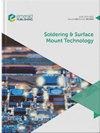多质量参数设计在下填工艺优化中的应用——以某汽车电子模块为例
IF 1.8
4区 材料科学
Q3 ENGINEERING, ELECTRICAL & ELECTRONIC
引用次数: 9
摘要
目的探讨影响焊锡质量特性的关键因素,如焊锡球数、残余底填物的分布距离和底填物的完成时间。设计/方法学/方法采用田口法配置正交试验表,安排试验进度并进行试验。此外,还采用主成分分析的方法得到了积分点。然后,基于灰色关联分析和理想解相似性排序偏好技术,采用各质量特征与理想解的接近程度作为评价质量特征的依据;结果提出了4点胶(11 mg/点胶)、“半流”间隔状态、80℃预热模块PCB板和l型点胶路径的最优参数组合,并进行了验证测试。独创性/价值对于车辆和手持电子产品,连接电子元件与印刷电路板的焊点可能因碰撞、振动或跌落而破裂。因此,焊料球被下填料紧密包围和保护,以提高接头强度并抵抗外力因素,如碰撞和振动。本文针对一种车载电子通信模块在下填后二次回流过程中产生的缺陷进行了研究。本文章由计算机程序翻译,如有差异,请以英文原文为准。
Application of multi-quality parameter design in the optimization of underfilling process – a case study of a vehicle electronic module
Purpose
This paper aims to discuss the key factors affecting the quality characteristics, such as the number of solder balls, the spread distance of residual underfill and the completion time of the underfilling.
Design/methodology/approach
The Taguchi method is applied to configure the orthogonal table and schedule and execute the experiment. In addition, principal components analysis is used to obtain the points. Then, based on gray relational analysis and the technique for order preference by similarity to ideal solution, the closeness between each quality characteristic and the ideal solution is adopted as the basis for evaluating the quality characteristics.
Findings
The optimal parameter combination is proposed, which includes 4 dispensing (11 mg/dispensing), a “half flow” interval state, 80°C preheating module PCB board and an L-shaped dispensing path and verification testing is performed.
Originality/value
For vehicles and handheld electronic products, solder joints that connect electronic components to printed circuit boards may be cracked due to collision, vibration or falling. Consequently, solder balls are closely surrounded and protected by the underfill to improve joint strength and resist external force factors, such as collision and vibration. This paper addresses the defects caused during the second reflow process of a vehicle electronic communication module after the underfilling process.
求助全文
通过发布文献求助,成功后即可免费获取论文全文。
去求助
来源期刊

Soldering & Surface Mount Technology
工程技术-材料科学:综合
CiteScore
4.10
自引率
15.00%
发文量
30
审稿时长
>12 weeks
期刊介绍:
Soldering & Surface Mount Technology seeks to make an important contribution to the advancement of research and application within the technical body of knowledge and expertise in this vital area. Soldering & Surface Mount Technology compliments its sister publications; Circuit World and Microelectronics International.
The journal covers all aspects of SMT from alloys, pastes and fluxes, to reliability and environmental effects, and is currently providing an important dissemination route for new knowledge on lead-free solders and processes. The journal comprises a multidisciplinary study of the key materials and technologies used to assemble state of the art functional electronic devices. The key focus is on assembling devices and interconnecting components via soldering, whilst also embracing a broad range of related approaches.
 求助内容:
求助内容: 应助结果提醒方式:
应助结果提醒方式:


